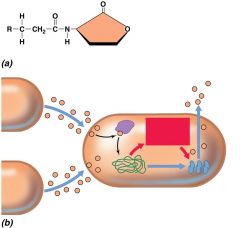![]()
![]()
![]()
Use LEFT and RIGHT arrow keys to navigate between flashcards;
Use UP and DOWN arrow keys to flip the card;
H to show hint;
A reads text to speech;
16 Cards in this Set
- Front
- Back
- 3rd side (hint)
|
Magnification
Def |
The degree by which an object appears larger than its actual size.
Ex; a bacterium 25 μm long when viewed under 1000x magnification will appear to be 25,000 μm. |
|
|
|
Resolution
Def |
efers to the size of the smallest detail visible, a by-product of a microscope’s resolving power.
|
|
|
|
Resolving power
Def |
A function of the λ of the illuminating source and the numerical aperture.
As λ (measured in nm) decreases, RP increases RP= ___ λ_______ 2 x NA |
|
|
|
Illumination Source
|
Source of light
λ (measured in nm) = distance between 2 peaks of a light wave |
|
|
|
Biofilm
Def |
Complex microbial communities
Characteristics? |
-Take place in a liquid and solid surface interface
-Differential gene expression |
|
|
Differential Gene Expression?
|
Not all the cells are producing the same microbial cells, but might create something different.
Cells at the surface may be creating different microbials cells then those in the center of the biofilm |
|
|
|
BioFilm Formation
Generic |
1. Trace organic molecules adhere to wall of surface.
2. Surface charge is neutralized, attracts free-floating ”pioneer” colonizers. 3. Initial colonizers attach using slime layers (a type of glycohalyx) or mechanical attachment proteins called fimbriae. Sheer force increases strength of fimbriae attachment. 4. Bacteria secrete polysaccharides and other exopolymers that creates a web trapping further metals and nutrients. 5. Secondary colonizers arrive, often using waste metabolites from pioneer bacteria as an energy source. 6. Using chemotaxis additional colonizers are attracted to the growing biofilm. 7. As the biofilm grows to a certain thickness it creates enough fluid turbulence which knocks off some of the bacteria. These microbes float downstream to attach to new surfaces. |
|
|
|
BioFilm Formation
P. aeruginosa |
1. Attachment via Type IV pili
2. Monolayer 3. Twitching ->micrcolonies 4. Polysaccharide secretion 5. Mature biofilm 6. Physical break-up or triggered release |
|
|
|
BioFilm Formation
Intracellular (e.coli) |
1. FimH adhesion at the tip of type I pili –attachment and invasion of bladder epithelial cells
2. Irregular rods -> matrix encased cocci – Would start to excrete exopolysaccharide and turn into one shape and take on an organized shape |
|
|
|
Mature Biofilms
|
Contain many species of microbes and may develop an oxygen gradient supporting anaerobic as well as aerobic growth.
|
|
|
|
PCD- Programmed Cell Death
|
Death when the population of the biofilm reaches a certain density. The die-off creates available surface for a new round of growth.
|
|
|
|
Quorum Sensing
Def? |
Density dependent communication
How does it work? |
Involves Signal molecule (autoinducers) + receptor protein.
Receptor binding at high enough level signifies presence of other bacteria. |
|
|
Quorum Sensing
Autoinducers Gram Positive and Gram Negative |
Gram Negative = Acyl Homoserine Lactones (AHL)
Gram Positive = eptides or modified peptide molecules |
|
|
|
Quorum Sensing
Autoinducers Types of AHI? |

Ai-1 – is intra specific communicating (same type)
Ai-2 – Is an inter specific communicatory (different types) |
|
|
|
Activities regulated by
|
1. Nutrient Cycling – Helps to avoid competition from other cells, cells making a decision to share the energy
2. Attachment 3. Detachment 4. Swarming Motility 5. Programmed Cell death 6. Sporulation 7. Release of virulence factors/toxins 8. Release of antibiotics 9. Increased genetic competence 10. Changes in cell wall structure 11. Activation of polysaccharide secretion pathways |
|
|
|
Why antibiotics are less effective against biofilms?
|
1. Fluid dynamics
2. Physical protection (polysaccharide layer or cellular layer) 3. Metabolic diversity 4. Acquisition of gene for antibiotic resistance 5. Programmed Cell death |
|

